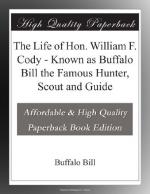On leaving Fort Laramie, Simpson was made brigade wagon-master, and was put in charge of two large trains, with about four hundred extra men, who were bound for Fort Leavenworth. When we came to Ash Hollow, instead of taking the usual trail over to the South Platte, Simpson concluded to follow the North Platte down to its junction with the South Platte. The two trains were traveling about fifteen miles apart, when one morning while Simpson was with the rear train, he told his assistant wagon-master, George Woods and myself to saddle up our mules, as he wanted us to go with him and overtake the head train.
We started off at about eleven o’clock, and had ridden about seven miles when—while we were on a big plateau, back of Cedar Bluffs—we suddenly discovered a band of Indians coming out of the head of a ravine, half a mile distant, and charging down upon us at full speed. I thought that our end had come this time, sure. Simpson, however, took in the situation in a moment, and knowing that it would be impossible to escape by running our played-out mules, he adopted a bolder and much better plan. He jumped from his own mule, and told us to dismount also. He then shot the three animals, and as they fell to the ground he cut their throats to stop their kicking. He then jerked them into the shape of a triangle, and ordered us inside of the barricade.
All this was but the work of a few moments, yet it was not done any too soon, for the Indians had got within three hundred yards of us, and were still advancing, and uttering their demoniacal yells or war-whoops. There were forty of the red-skins and only three of us. We were each armed with a Mississippi yager and two Colt’s revolvers.
“Get ready for them with your guns, and when they come within fifty yards, aim low, blaze away and bring down your man!”
Such was the quick command of Simpson. The words had hardly escaped from his mouth, when the three yagers almost simultaneously belched forth their contents. We then seized our revolvers and opened a lively fire on the enemy, at short range, which checked their advance. Then we looked over our little barricade to ascertain what effect our fire had produced, and were much gratified at seeing three dead Indians and one horse lying on the ground. Only two or three of the Indians, it seemed, had fire-arms. It must be remembered that in those days every Indian did not own a needle gun or a Winchester rifle, as they now do. Their principal weapons were their bows and arrows.
Seeing that they could not take our little fortification, or drive us from it, they circled around us several times, shooting their arrows at us. One of the arrows struck George Wood in the left shoulder, inflicting only a slight wound, however, and several lodged in the bodies of the dead mules; otherwise they did us no harm.
The Indians finally galloped off to a safe distance, where our bullets could not reach them, and seemed to be holding a council. This was a lucky move for us, for it gave us an opportunity to reload our guns and pistols, and prepare for the next charge of the enemy. During the brief cessation of hostilities, Simpson extracted the arrow from Wood’s shoulder, and put an immense quid of tobacco on the wound. Wood was then ready for business again.




